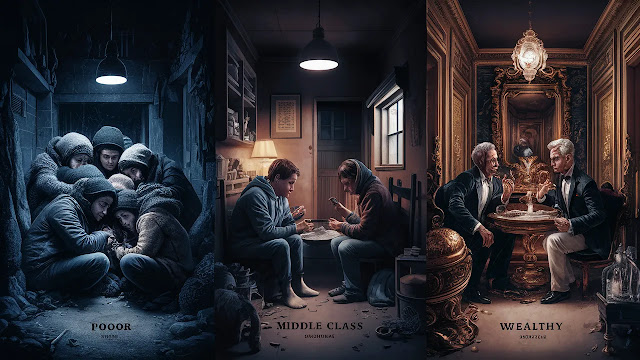The Rich buy assets and focus on their asset column while everyone else focuses on their income. This simple yet profound statement highlights the fundamental difference between those who build wealth and those who struggle financially. But what does this all mean? Assets will make you money at the end of every month while expenses will cost you money at the end of every month. In this article, we will delve deeper into the world of assets and liabilities, exploring the strategies employed by the Rich, the Poor, and the Middle Class.
The Poor: Living in a World of Expenses
The Poor only have expenses. They struggle to make ends meet, constantly worrying about how they will pay their bills. Their financial lives are a never-ending cycle of debt and financial stress. The Poor often rely on credit cards, loans, and other forms of debt to make ends meet, further exacerbating their financial woes.
The Middle Class: Buying Liabilities They Think Are Assets
The Middle Class buy liabilities they think are assets. They invest in things like cars, houses, and other consumer goods, believing that these purchases will increase their wealth. However, these purchases often become liabilities, draining their finances and limiting their ability to build wealth. For example, a car is a huge liability even though it could be considered an asset. Think about it - you pay for gas, insurance, repairs, and maintenance, and the value of the car goes down with every mile you put on it. People who buy those nice shiny cars are invested heavily into expenses.
The Rich: Building Wealth through Assets
The Rich, on the other hand, focus on building wealth through assets. They invest in things like real estate, stocks, and other forms of passive income. These assets generate money at the end of every month, providing a steady stream of income and building wealth over time. The Rich understand that assets are the key to financial freedom, and they make conscious decisions to invest in these assets.
The Power of Real Estate Investing
Personally, I want to save money to invest in real estate - more specifically, multi-unit housing. The best part is you don't need the whole listing price to buy the property; most of the time, you only need about 20% and can get a loan from the bank for the rest. Let me play out a little scenario for you. There is a 4-unit apartment building on the market for $100,000. Rent for each unit is $500 per month, or $2,000 in total for all 4 units.
- 20% of $100,000 is $20,000. Perfect. You go to the bank with the $20,000 and the bank gives you a loan for the remaining balance. This is called a mortgage. You will be paying the mortgage off over 30 years in monthly payments.
- $80,000 mortgage/ 30 years = $2,667 yearly payment
- $2,667 yearly payment/ 12 months = $222 monthly payment
So wait a second. You are paying $222 a month on the mortgage but you are collecting $2,000 a month in rent?
- $2,000 - $222 = $1,778 that goes into YOUR pocket at the end of every month. Yes, it will take you about a year to get back to your break-even point of $20,000 but then you will still be collecting rent checks every year until you die or decide to sell the property (and upgrade to 8 units!)
That, my friend, is an asset.
Conclusion
The Rich buy assets. The Poor only have expenses. The Middle Class buy liabilities they think are assets. The key to financial freedom lies in understanding the power of assets and liabilities. By investing in assets that generate passive income, individuals can build wealth over time and achieve financial freedom. For further reading, I'd recommend "The Richest Man in Babylon," you can find it on Amazon for about $25.




0 Comments